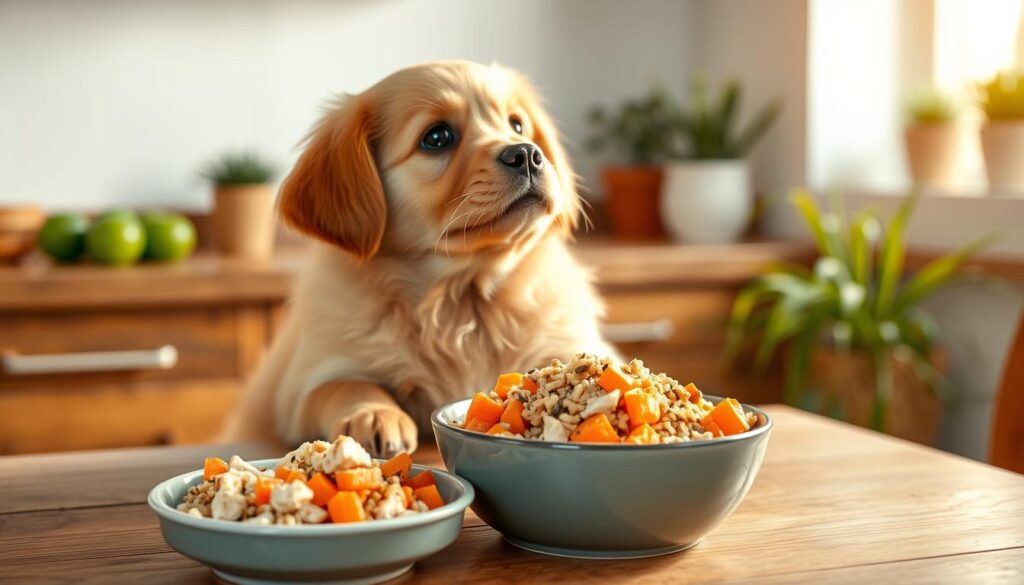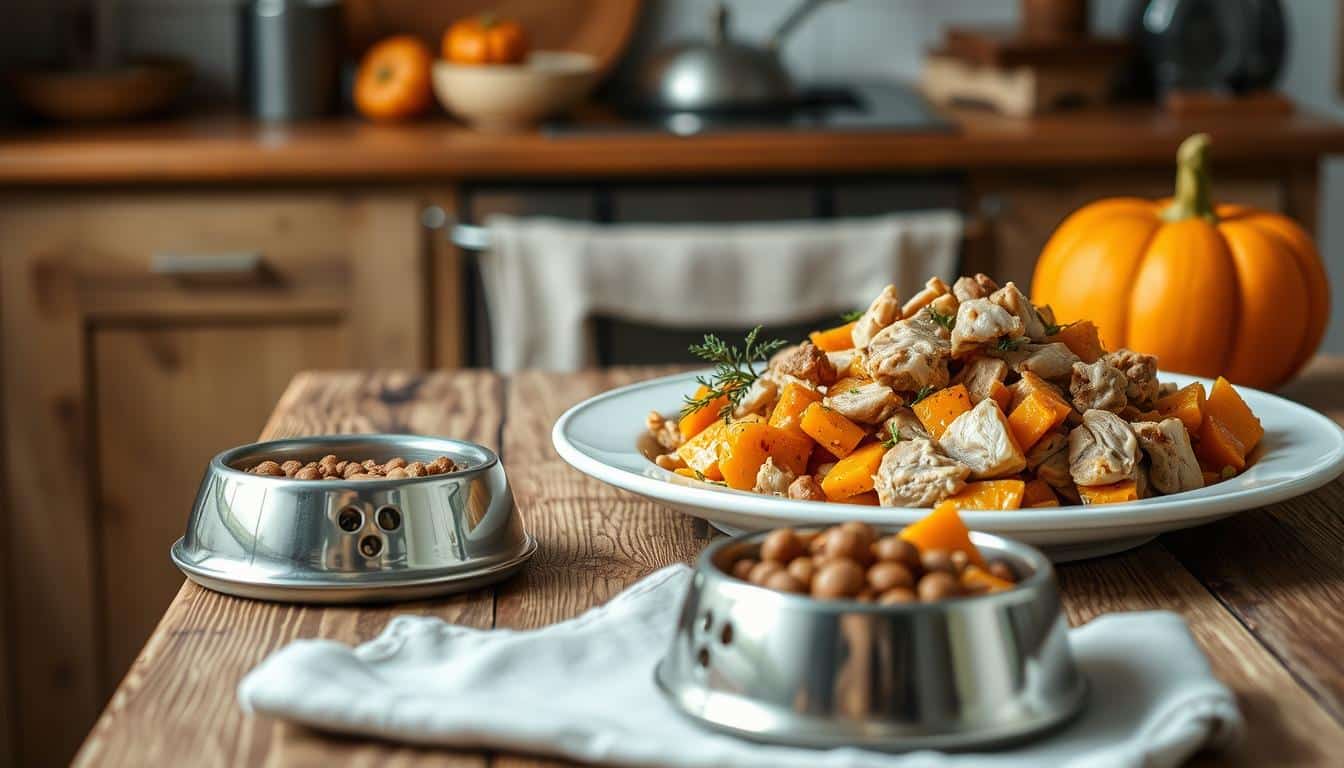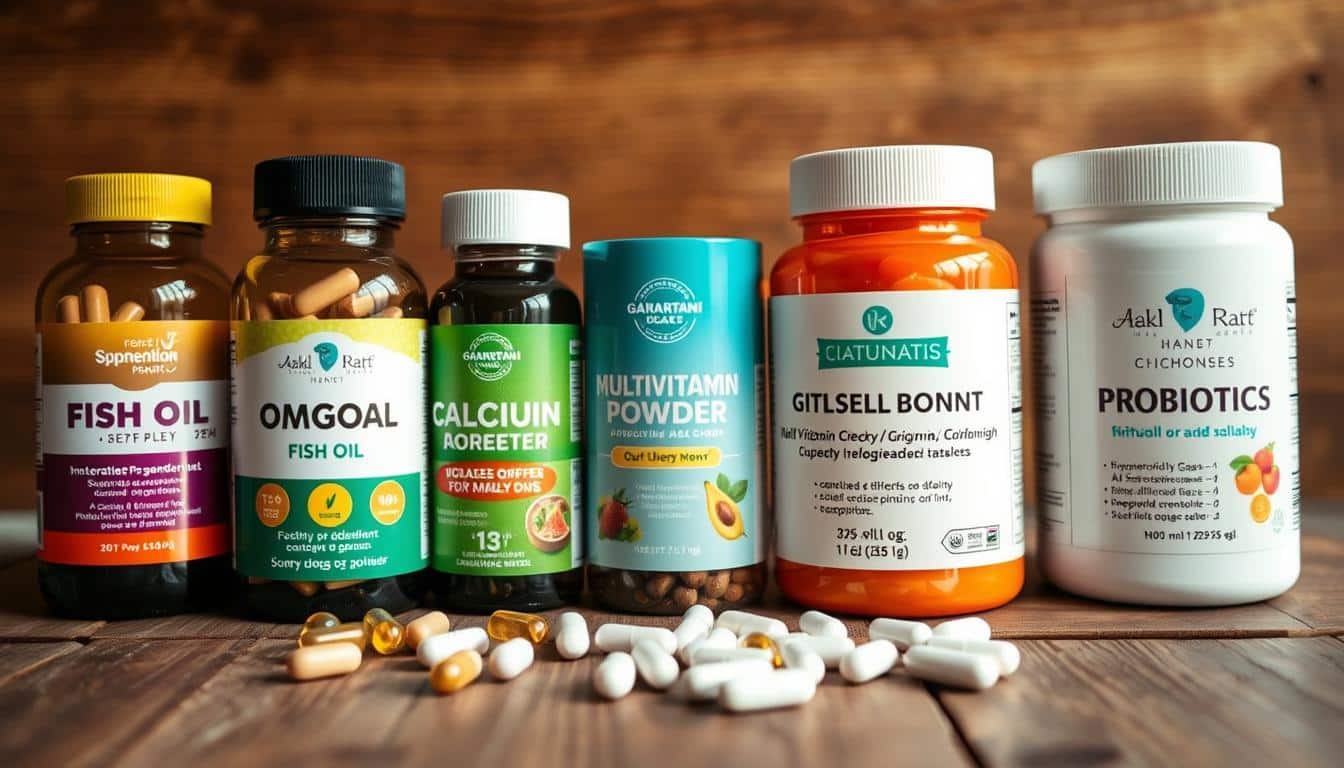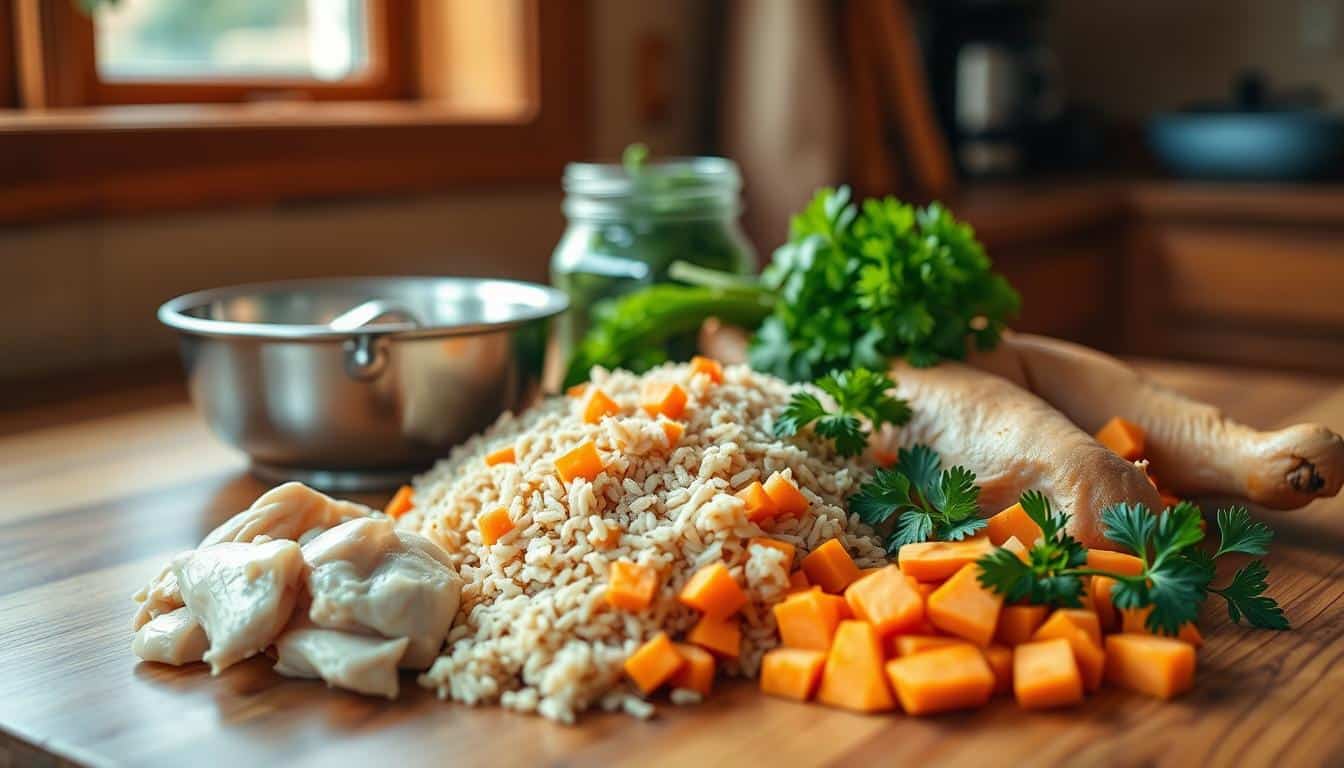Does your small dog itch, lose hair, or get ear infections often? A special diet free from common allergies might help. Making your own dog food means you can avoid things like wheat and dairy. This can often make your dog feel better in just a few weeks, with advice from the vet.
Grain-free meals for dogs focus on good proteins and omega-3 sources. Think turkey, venison, salmon, or flaxseed. They also include healthy fibers from foods like pumpkin and sweet potatoes. This mix helps with skin health and reduces inflammation from grains. You should feed them about 2% of their body weight daily, which is often 1/2 cup per each 10 pounds they weigh.
Work with your vet to figure out what’s causing your dog’s allergies. With their help, you can make sure your homemade dog food is both safe and full of nutrients. Grain-free recipes let you carefully pick ingredients, notice any changes in your dog, and make a delicious meal they’ll love.
Understanding Food Allergies in Small Dogs
Owners of small breeds may spot skin or stomach issues. These signs could mean food allergies. Catching this early helps avoid long-term problems. Knowing what to look for and working with a vet makes managing easier.
Common symptoms to watch for
- Persistent itching, licking, or scratching, especially at paws and base of tail.
- Recurring ear infections and red, inflamed skin that may lead to hot spots.
- Digestive upset such as vomiting or diarrhea and frequent licking of lips or feet.
These could be food allergy signs, but also from fleas or the environment. Note when they happen to help find the cause.
Typical food culprits for canine allergies
- Dairy, wheat, and eggs
- Soy and beef
- Less common proteins such as chicken in some dogs
Many dog foods have proteins and grains that can cause allergies. Trying different proteins helps find what’s causing the issue.
Diagnosing food allergies
Starting with a full check-up, your vet will rule out other causes. Then, they’ll look at the dog’s diet.
Next step is an elimination diet. Dogs eat certain foods for a while, then slowly add back in others. This finds what’s causing the reaction.
Blood or skin tests aren’t as good for finding food allergies. A vet’s help is key to safely figuring out the problem.
Why Choose Grain-Free Diets for Allergic Small Dogs
Many small dogs have skin issues, constant itching, or dull fur because of wheat and corn. A grain-free diet can lower their exposure to these irritants. Owners often notice better skin and less itching with a well-chosen and balanced grain-free diet.
Benefits of removing grains
Taking grains out of the diet helps avoid common allergens, reducing itchiness and hot spots. Owners can tailor homemade grain-free meals. They can choose unique proteins like turkey or venison.
This diet can make fur shinier and lower ear infection risks from food allergies. It makes tasty meals that even picky small dogs will eat, while also easing their symptoms.
Key nutrients to preserve in grain-free recipes
Without grains, it’s important to find other sources for essential nutrients. Focus on lean proteins, omega-3 from fish or flaxseed, and fruits and veggies packed with antioxidants.
For good gut health and solid poops, sweet potato and pumpkin can replace grains. These provide digestible carbohydrates and fiber but avoid the proteins in common grains.
- Protein: turkey, venison, or whitefish to maintain roughly half the diet by weight.
- Carbohydrates and fiber: sweet potato, pumpkin, peas as grain alternatives for dogs.
- Fats and omegas: wild salmon, sardines, or flaxseed to supply DHA and EPA.
- Calcium and micronutrients: eggshell powder or bone meal plus dark leafy greens.
For balanced grain-free meals, aim for 50% protein, 25% digestible carbs, and 25% veggies. Add necessary fats and calcium. Consulting a vet or nutrition expert ensures your dog’s diet is both safe and meets their needs when avoiding grains.
Essential Ingredients for Grain-Free Recipes
Picking the right ingredients helps make food safe and healthy for small dogs with allergies. Look for proteins that minimize allergic reactions, easy-to-digest carbs, and fats plus supplements for healthy skin, coat, and bones.
Protein choices safe for allergic dogs
For dogs with allergies, venison, duck, rabbit, and whitefish are great protein options. Lean meats like turkey and chicken are okay if your dog doesn’t react to them. Organ meats are good in small amounts for vitamins and minerals.
- Venison: low allergenicity and nutrient dense.
- Duck and rabbit: good alternatives for persistent sensitivities.
- Whitefish: useful for rotation and for omega-3 for dogs.
- Turkey or chicken: lean muscle support when tolerated.
Grain-free carbohydrate and fiber sources
Sweet potato, pumpkin, and quinoa that your dog can eat are good for energy and fiber. Pumpkin and sweet potato can help make your dog’s stools firm and steady the gut. Include various vegetables for vitamins but without grains.
- Sweet potato: rich in beta-carotene and soluble fiber.
- Pumpkin: gentle on digestion and improves stool quality.
- Quinoa: use only if your dog shows no intolerance.
- Mixed vegetables: low-starch choices for micronutrient variety.
Fats, supplements, and micronutrients
Healthy fats are vital. Fish oil and flaxseed oil provide omega-3s to lower inflammation and boost coat health. Sunflower seed oil is another good fat source. You can use baked and crushed eggshells or vet-approved calcium supplements for your dog’s bones.
- Omega sources: fish oil for EPA/DHA, flaxseed oil for ALA.
- Calcium options: ground eggshells prepared safely, or professional supplements.
- Micronutrients: organ meats and balanced dog food supplements help prevent deficiencies.
Always talk to your vet before adding supplements or changing your dog’s calcium intake. It’s important to make sure everything is right for your dog’s needs and allergy conditions.
Recipe: Turkey and Sweet Potato Delight (Grain-Free)
This recipe is perfect for small dogs who can’t eat certain foods. It uses lean turkey, simple starch from sweet potatoes, and healthy fats. These ingredients help with digestion and keep the skin healthy. Just follow the simple steps below and adjust the food amount based on your dog’s size and energy level.
- Ingredients
- 1 cup cooked ground turkey (lean)
- 1/2 cup mashed sweet potatoes (plain, no sugar)
- 1/4 cup cooked peas
- 1 tbsp olive oil or coconut oil
Ingredients and why they help
Turkey is a great protein that doesn’t upset allergic dogs’ stomachs. Sweet potato gives fiber and easy-to-digest carbs, which are good for the belly. Peas bring more fiber and nutrients without the allergy risks of grains. Olive or coconut oil keeps the skin and fur in good shape.
Preparation and portion guidance for small breeds
First, cook the turkey until it’s fully done. Then, make the sweet potato soft by steaming or boiling it and mash it up. Make sure the peas are cooked until they’re tender. Mix all the cooked items together, blend in the oil, and let it cool down before you feed your dog.
A good rule is to give about 1/2 cup for every 10 pounds your dog weighs. This should be about 2% of their total body weight each day, split between two meals. Change the amount if your dog is more or less active. For dogs with food allergies, begin with small portions to check for any bad reactions.
When starting your dog on this new turkey and sweet potato recipe, take it slow. Mix it with their current food little by little over 7–14 days. Watch how they react in terms of their energy, stools, and skin condition. Always get advice from your vet to make sure this diet is right for your pet.
Recipe: Salmon and Quinoa Medley Adapted for Grain Sensitivities
This simple recipe is great for small dogs with sensitive stomachs. It uses salmon for omega-3 support and quinoa instead of common grains. You can change the ingredients to fit grain-free diets or specific allergies.
Here’s what you need for a small dog: 1/2 cup of cooked, flaked salmon; 1/2 cup of cooked quinoa; 1/4 cup of steamed carrots; and 1/4 cup of steamed green beans. This blend provides protein, fiber, and vitamins. It’s also soft for easy chewing.
Make this dog-friendly salmon recipe by cooking the salmon well and then flaking it. Make sure to pick out all the bones. Let the food cool down before you give it to your dog. Start with small amounts when introducing new proteins.
Ingredient substitutions for strict grain-free plans
- Use cooked sweet potato instead of quinoa for a safe starch option.
- If your dog likes legumes, try using canned pumpkin or more peas and green beans.
- Change salmon to trout or sardines to avoid allergic reactions, picking fillets without bones.
Preparation tips and serving safety
- Make sure the salmon is cooked until it’s not see-through. Steaming or baking it will keep its natural oils.
- Steam veggies until they’re soft to help small dogs digest them better.
- Check for bones in the fish carefully to avoid any choking hazards.
- For more omega-3s, add a teaspoon of fish oil or flaxseed oil to each meal.
- Introduce salmon slowly to dogs with allergies, watching their skin and poop over 7–10 days.
Recipe: Whitefish and Carrot Mix for Sensitive Stomachs
This recipe is perfect for small dogs with sensitive stomachs. It’s great for using as a temporary meal or regularly to give your dog a different protein. It’s a grain-free meal with whitefish that helps with digestion and keeps the skin healthy.
Why pick whitefish as the main protein? It’s less likely to cause allergies and is easy for dogs to digest. This makes it a great choice for a diet with different sources of protein.
Ingredients and simple notes:
- Cooked, flaked whitefish (cod, pollock, or haddock) — it’s light and not fatty.
- Steamed carrots — they add fiber and vitamins that are easy on the stomach.
- Optional grain-free binder: mashed pumpkin or pureed sweet potato for better texture and digestive health.
- One tablespoon of fish oil per batch for omega-3s, which help with skin and coat health.
Basic cooking method:
- Cook the fish until it’s not see-through anymore and break it into small bits.
- Cook the carrots until they’re soft, then chop or mash them so they’re easier to digest.
- Mix the fish and carrots with your chosen binder. Add fish oil after it cools to keep the good stuff in.
Serving and storage tips:
- Start giving your dog this whitefish meal slowly to see if they have any bad reactions.
- Always serve it at room temperature to help dogs with sensitive stomachs.
- Keep it in the fridge for up to three days or freeze it to use later.
This whitefish meal is a gentle option for dogs that need soft food for their stomachs. Change how much you give them based on their size, how active they are, and what your vet says.
Recipe: Venison and Sweet Pea Blend for Novel-Protein Diets
This venison dog recipe is perfect for small dogs on a special diet. It can be a good choice if common proteins cause allergies. The recipe uses lean venison to maintain muscle mass in little, active dogs. Make it with cooked, diced venison for a simple, healthy meal.
Benefits of venison for allergy elimination
Venison is a new kind of protein for many pets. Using venison can help avoid allergic reactions that beef, chicken, or pork might cause. It can help pets get better from skin and stomach problems caused by food allergies.
For really small dogs, pick lean venison and trim off any extra fat. This helps digestion and preserves essential nutrients. A grain-free venison recipe can be great for testing for allergies or for short diets to find allergies.
Mixing and storage advice
Mix cooked venison with sweet peas and a tablespoon of coconut oil. Coconut oil is a healthy fat that also makes your dog’s coat shiny. If you’re avoiding grains, use more veggies or some cooked sweet potato instead of quinoa.
- Portion it small for easy eating, using a 2-to-1 ratio of meat to veggies for small dogs.
- Think about adding a bit of ground eggshell or a dog vitamin to keep up with calcium needs if this replaces regular meals.
Store homemade meals in the fridge for up to three days. For keeping it longer, freeze it and label each container. Thaw it in the fridge before use and warm it gently if your dog likes their food warm. Make sure it cools down before you feed your dog.
- Fully cook the venison, cool it, then cut it up.
- Cook sweet peas until they’re soft, then let them drain.
- Stir together the venison, peas, and coconut oil. Add more veggies or sweet potato for a strict grain-free recipe.
- Divide it into portions for the fridge or freezer, using safe food storage practices.
Keep a journal of your dog’s food when trying venison. Write down any changes in how much they itch, their poop, or energy levels. This info helps you and your vet figure out if the venison recipe should stay in your dog’s diet long-term.
Transitioning Safely to a Homemade Grain-Free Diet
Moving your small dog to a homemade grain-free diet needs careful steps. You want to lessen allergy triggers, ensure the diet is complete, and avoid tummy troubles. Keep an eye on their poop, energy, skin, and fur as you switch foods.
Stepwise introduction to avoid digestive upset
Introduce the new diet over 7 to 14 days. Start by mixing 10% of the homemade food with their usual food on day one. Then up the homemade food by 10-15% each day until it’s all homemade.
If you see loose poop, throwing up, or less energy, stop the change for 48 hours and talk to your vet. For small dogs, it’s best to change their food more slowly.
- Days 1–3: 10–25% homemade, check poop daily.
- Days 4–7: 30–60% homemade, watch for good energy and hunger.
- Days 8–14: 70–100% homemade, adjust food amounts and add-ons.
Working with your veterinarian or veterinary nutritionist
Work with your vet to use a special diet plan. This helps find out what foods cause allergies. A homemade diet with few ingredients is good for testing while avoiding problem foods.
Make sure the diet has everything your dog needs before sticking with it long-term. Use eggshell powder or a supplement for calcium, add fish oil for important fats, and include a vitamin mix for dogs as recommended. It’s best to get advice from a vet who knows about dog diets.
Write down everything about the new ingredients and how your dog reacts. Good notes help your vet figure out the problem foods and make the diet better. This way, you can make sure your dog’s diet is healthy and safe.
Feeding Guidelines, Portions, and Nutritional Balance for Small Breeds
Making food at home for small dogs needs clear guidelines. A guide can help you set the right portions, count calories, and keep the food balanced. Start with a basic approach and tweak it based on your dog’s age, how active they are, and their overall health.

Portion sizes for small dogs can vary. Start with these tips and adjust as needed.
- About 1/2 cup per 10 pounds of body weight per day is a good place to start.
- Or, try feeding about 2% of your dog’s total body weight each day, split into two or three meals.
- Increase the amount for dogs that are very active, and lower it for those that are less active or overweight.
It’s easier to manage your dog’s diet with homemade dog food calorie guides. Keep track of calories for every recipe and see how they fit your dog’s daily needs.
- First, figure out how many calories are in each cup of the recipe, then split that by the number of servings.
- Make sure the daily calorie amount matches your dog’s weight and stage in life.
- Each week, adjust the calories based on your dog’s weight and health.
For small dogs, balance is as crucial as how much you feed them. It’s important to have a plan for what types of nutrients they’re getting to avoid missing anything important.
- Aim for about 50% of their calories from protein, 25% from starch or safe alternatives, and the last 25% from vegetables.
- Include fats that are easy to digest, like fish oil or olive oil, for energy and good skin.
- Also, make sure they’re getting enough calcium and trace minerals. You can use bone meal, eggshell powder, or a special vet-recommended supplement.
Keep track of the most important nutrients in each batch of food. If your recipes don’t have enough iron or vitamins, add organ meats. This step helps ensure your dog gets everything they need.
Talk to a vet or a specialist in animal nutrition when planning your dog’s homemade diet. They can suggest good supplements if needed. They can also help make sure your dog’s diet matches their health requirements.
Regular weight checks and health assessments can help you stay on track. Use the homemade feeding guide, adjust the food amount as needed, and keep an eye on calories. This approach helps keep your dog healthy and full of energy.
Grain-free recipes for small allergic dogs
Start by rotating meals to keep your small dog’s diet varied and safe. A grain-free plan cuts out common allergy triggers, offers needed nutrients, and keeps meals the right size. Pay attention to your dog’s reaction and add bone broth for more taste and water.
- Rotate novel proteins such as whitefish, venison, and duck to lower the chance of sensitization.
- Prepare bone broth by roasting bones, then simmering 8–24 hours and straining; add modest amounts to meals for joint and skin support.
- Store fresh batches in the refrigerator up to three days or freeze single portions for convenience.
Sample weekly meal plans help feed your dog without grains in a balanced way. You’ll need a lean protein, a safe veggie, and a healthy fat. Change the protein every few days to keep meals interesting and nutritious.
- Monday: Turkey and sweet potato mix with a splash of bone broth.
- Tuesday: Salmon with quinoa alternative or zucchini for strict grain-free plans.
- Wednesday: Whitefish and carrot blend, lightly steamed.
- Thursday: Venison with sweet peas and a teaspoon of fish oil.
- Friday: Duck with mashed kabocha squash and bone broth.
- Weekend: Rotate smaller portions of the week’s favorites to keep variety.
Rotating proteins helps you see what your dog can handle and avoids relying too much on one ingredient. Keep a meal log to identify any diet patterns or issues.
Look out for signs of dietary reactions such as more itching, stomach troubles, ear infections, or tiredness. If these happen, stop the new food right away.
- If symptoms start or worsen, remove the suspected meal and consult your veterinarian.
- If problems persist, perform another elimination or allergy workup under veterinary supervision.
- Consider referral to a veterinary nutritionist for balanced long-term plans when homemade feeding continues.
Make sure portions are right for small dogs and change their diet slowly. A good weekly meal plan and careful watching let you feed your dog with confidence and solve diet issues.
Conclusion
Switching a small dog to grain-free food can help them avoid common allergies like wheat and corn. It often makes their skin and coat healthier, as long as their diet stays balanced. It’s important to use new protein sources, grain-free veggies like sweet potato and pumpkin, and omega-3s to keep their skin and immune system strong.
Moving your small dog to grain-free food should be done slowly. Watch how it affects their skin, ears, and stomach. Always work with a vet or a nutrition expert to make sure your dog’s diet is complete and suitable, because each dog’s health is different.
When making homemade grain-free food, keep meals safe and full of nutrients. Use organ meats and the right amount of calcium as recommended. Store single servings in the fridge for up to three days, and freeze anything you won’t use right away. This careful, informed way of feeding grain-free supports your dog’s health without missing essential nutrients.
FAQ
What are the most common signs my small dog has a food allergy?
Which foods most often trigger allergies in dogs?
How is a food allergy diagnosed in dogs?
Why choose a grain-free diet for an allergic small dog?
If I remove grains, what nutrients must I keep in the recipe?
Which proteins are best for elimination diets and allergic dogs?
What grain-free carbohydrate and fiber sources work well?
What fats, supplements, and micronutrients should I include?
How do I prepare and portion the Turkey and Sweet Potato recipe for a small dog?
My dog is grain-sensitive—can I still use the Salmon and Quinoa recipe?
Why is whitefish a good choice for sensitive stomachs?
How should I mix and store venison or other homemade meals?
How do I transition my dog to a homemade grain-free diet safely?
What portion and calorie rules apply to small breeds?
How can I ensure homemade meals are nutritionally balanced long term?
Can homemade grain-free diets reduce my dog’s itching and skin problems?
What signs mean I should stop the diet and see my veterinarian?
How do I identify the single ingredient that triggers my dog’s allergy?
Are there practical tips for preparing and storing homemade meals?
How often should I rotate proteins and why?
Can early antibiotic exposure affect my dog’s allergy risk?
Content created with the help of Artificial Intelligence.



